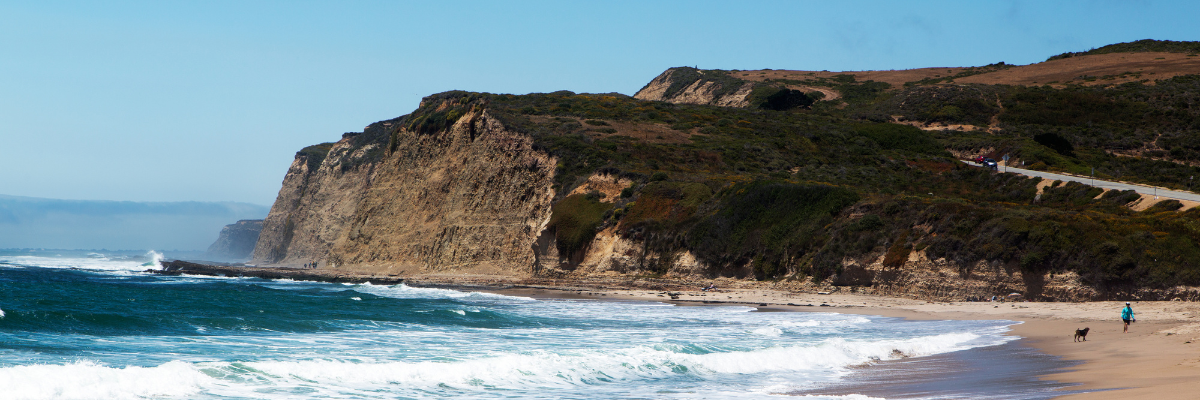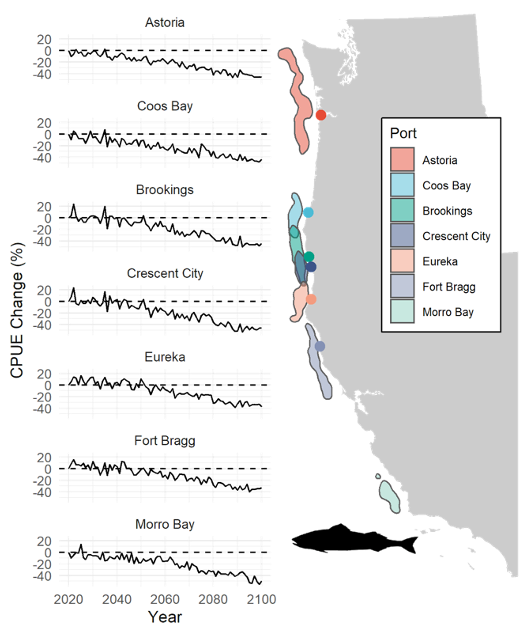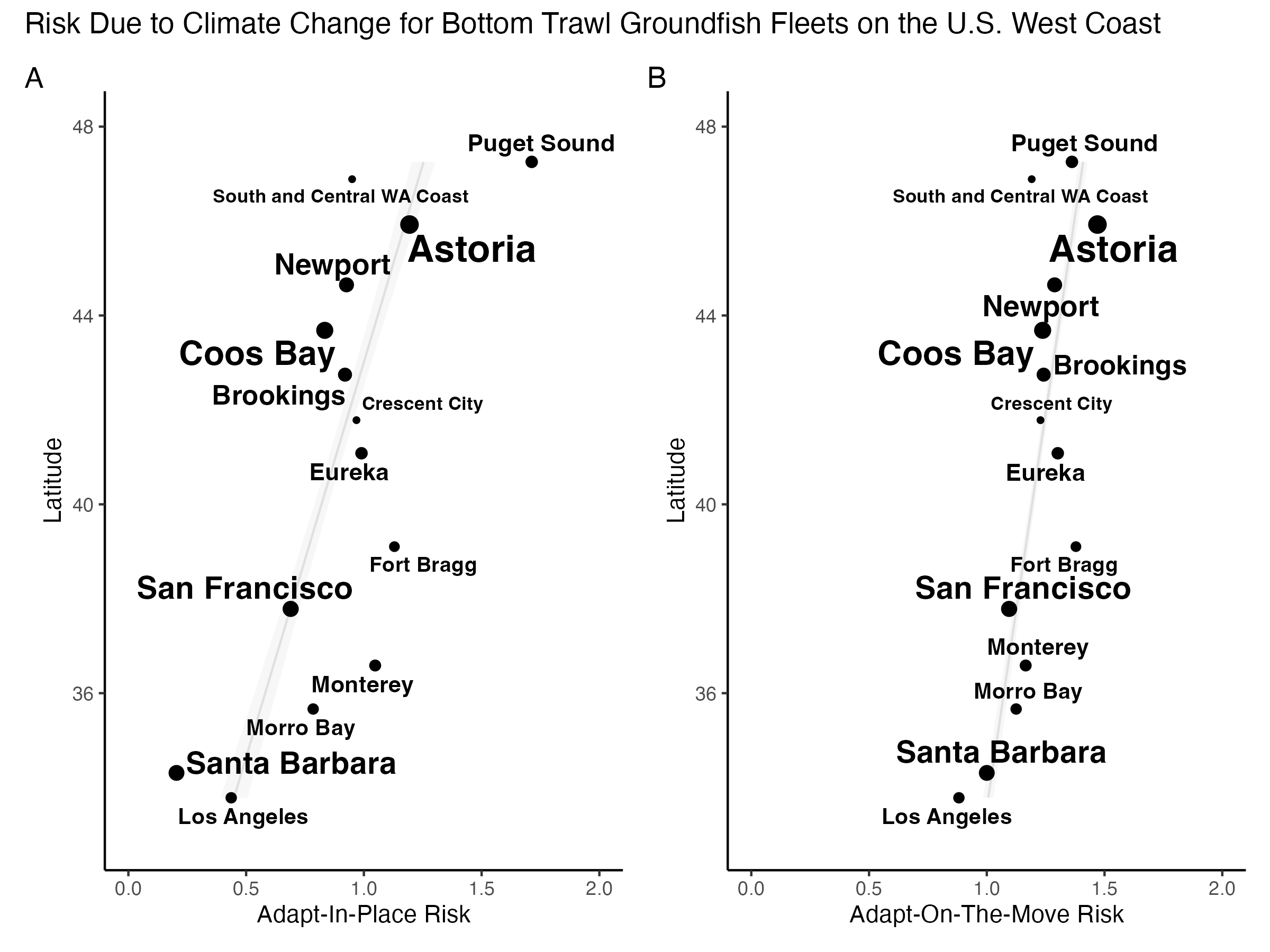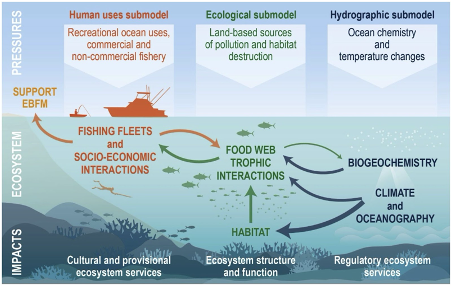[toc]
What is GC5?
The Groundfish, Climate Change, and Communities in the California Current (GC5) project is a collaboration between the Northwest and Southwest Fisheries Science Centers, the NOAA Fisheries Western Regional Office, and multiple academic institutions. These collaborators are working together to (a) improve understanding of how climate variability and change influence availability of groundfish to fisheries and fishing communities along the US West Coast, and (b) determine how existing fisheries management approaches perform under climate change and in an uncertain future.
GC5 Goals
Recognizing the intersectional nature of the challenges posed by climate change for the highly important US West Coast groundfish fishery, the GC5 project has brought together an interdisciplinary team of experts from across the west coast. The overall goals of the GC5 project (Fig. 1) are to:
- Determine environmental affinities of groundfish based on ocean observations and ocean models;
- Project expected groundfish distribution shifts using ocean models;
- Assess tradeoffs in stock availability to specific communities and evaluate the sustainability of current management strategies;
- Provide the Pacific Fishery Management Council with an understanding of how scenarios from the Climate and Communities Initiative may influence performance of existing groundfish fisheries management approaches.
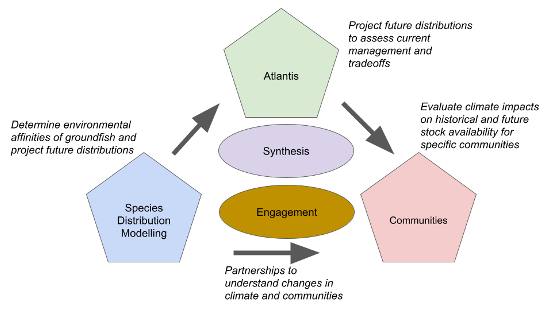
Groundfish Species Distribution Models
We are developing new models to explore the responses of key groundfish species to future changes in bottom temperature and oxygen that are expected under climate change. These models, fit to historical West Coast Bottom Trawl Survey data and then projected with multiple, dynamically-downscaled simulations of future ocean conditions, are already revealing how climate change effects on groundfish will manifest differently in different parts of the west coast. Some of the most coveted groundfish species, such as sablefish, are highly likely to decline in abundance and also shift their distribution deeper, becoming more difficult to target for groundfish trawlers (see Fig. 2). For other species, their outlook is not as dire, and some common species may even increase in abundance as ocean temperatures warm. For more details, link here to this recently published paper and summary web story.
Models and findings from the SDM Module are informing the other core GC5 modules. Distribution model outputs are being used to drive the distribution of species within the Atlantis Module, and findings from species distribution projections are helping to provide context for the consideration of adaptive management strategies and fishing community resilience that is being assessed in the Communities Module.
For more information, contact owen.liu at noaa.gov
Climate Change and West Coast Fishing Communities
From fishers to farmers, people that rely directly upon natural resources for their livelihoods and well-being face extensive impacts of climate change. While there is widespread appreciation that ecological impacts will intersect with existing socioeconomic conditions to determine vulnerability, for fisheries there remains a limited understanding of how these influences vary geographically and therefore how adaptation pathways may differ for specific communities. This module of the GC5 project endeavors to shrink this gap.
Our group is pursuing three parallel and related efforts to understand vulnerability and resilience of groundfish fishing communities on the US West Coast (Fig. 3). First, we are exploring definitions of fishing communities, ranging from place-based (e.g., Astoria, Oregon) to practice-based (e.g., bottom trawlers that catch primarily sablefish off the coast of southern Oregon and northern California). Clear definitions like these can be operationalized to provide more informative evaluations of vulnerability and adaptive capacity to potential climate impacts, including spatial shifts of socially and economically important marine species. A recent publication by Samhouri et al. highlights how climate change affects these different fleets unequally.
Second, we are developing climate-ready indicators to sustain fishing communities and promote ecosystem-based fisheries management. Such information will be valuable to better ensure that fisheries management actions taken to reduce climate impacts will have net positive impacts for coastal community economies and sustained fishing participation.
Third, we are employing novel methods that draw on multiple, dynamically-downscaled simulations of future ocean conditions as well as historical observations of economic dependence, mobility, and flexibility to assess the vulnerability of fishing fleets to climate change.
Ecosystem Models for Management Strategy Evaluations
Within the GC5 project, the California Current Atlantis simulation model provides a glimpse of future oceanography, ecology, food web dynamics, and fishing opportunities, and how these may evolve over the coming decades under climate change. We use the Atlantis modeling framework (Fig. 4), developed by CSIRO Australia, and implemented around the world. We focus on groundfish fisheries and fishing communities, and a parallel project (Future Seas) looks at pelagic species.
Atlantis simulates the ecology of groundfish, their prey, predators, and other food web components. For instance, we have incorporated new plankton survey data from CalCOFI and NOAA NWFSC, and updated diets from the California Current Trophic Database. For the US West Coast, this database is the first coastwide repository of scat and stomach contents data at the level of individual predators. This provides a synoptic view of diets and predator-prey linkages for groundfish.
We will use Atlantis modeling as a strategic tool to evaluate alternative management strategies that may be more robust to climate change. Within GC5 we will test performance of the existing threshold harvest control rules, compared to alternative approaches that incorporate additional ecosystem information. We aim to score management strategies based on how well they perform for human communities that depend on our groundfish resources.
Science in Service of Management: Engagement and Outreach
Through our roles on the PFMC Ecosystem Workgroup and as co-leaders of the CCIEA teams and its annual Ecosystem Status Report to the PFMC, we are communicating our process and products to federal fisheries managers on a routine basis. We have developed this work to springboard off of the PFMC Climate and Communities Initiative and are currently using our research to inform the current Ecosystem Initiative 4 (EI4) and ESR Climate Change Appendix. EI4 is focused on integration of climate and ecosystem information into harvest advice for fisheries managers, while the Climate Change Appendix is a supporting document to inform medium- to long-term strategic planning across all federally managed fisheries
